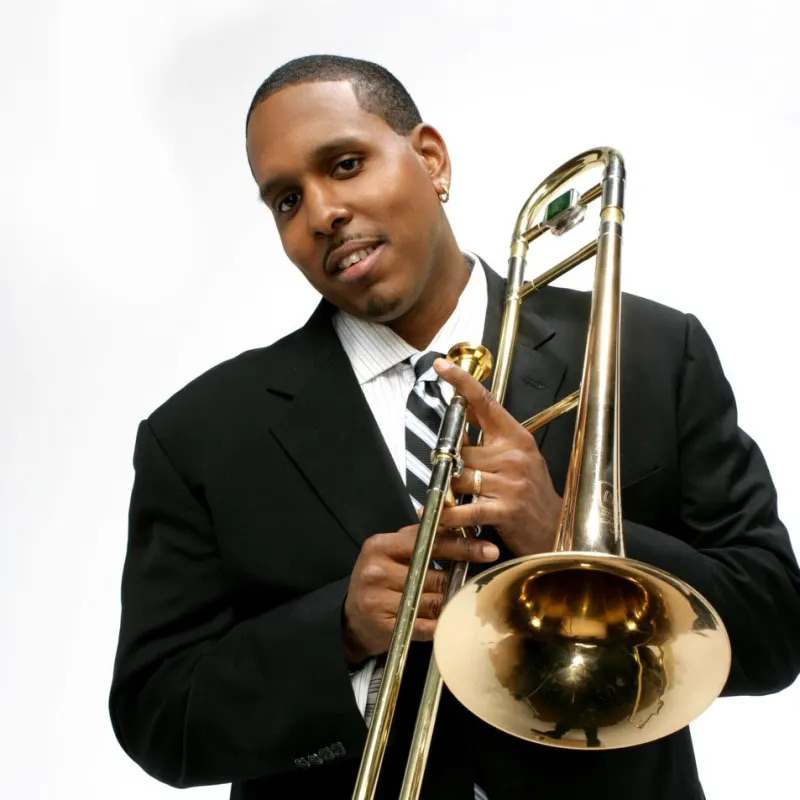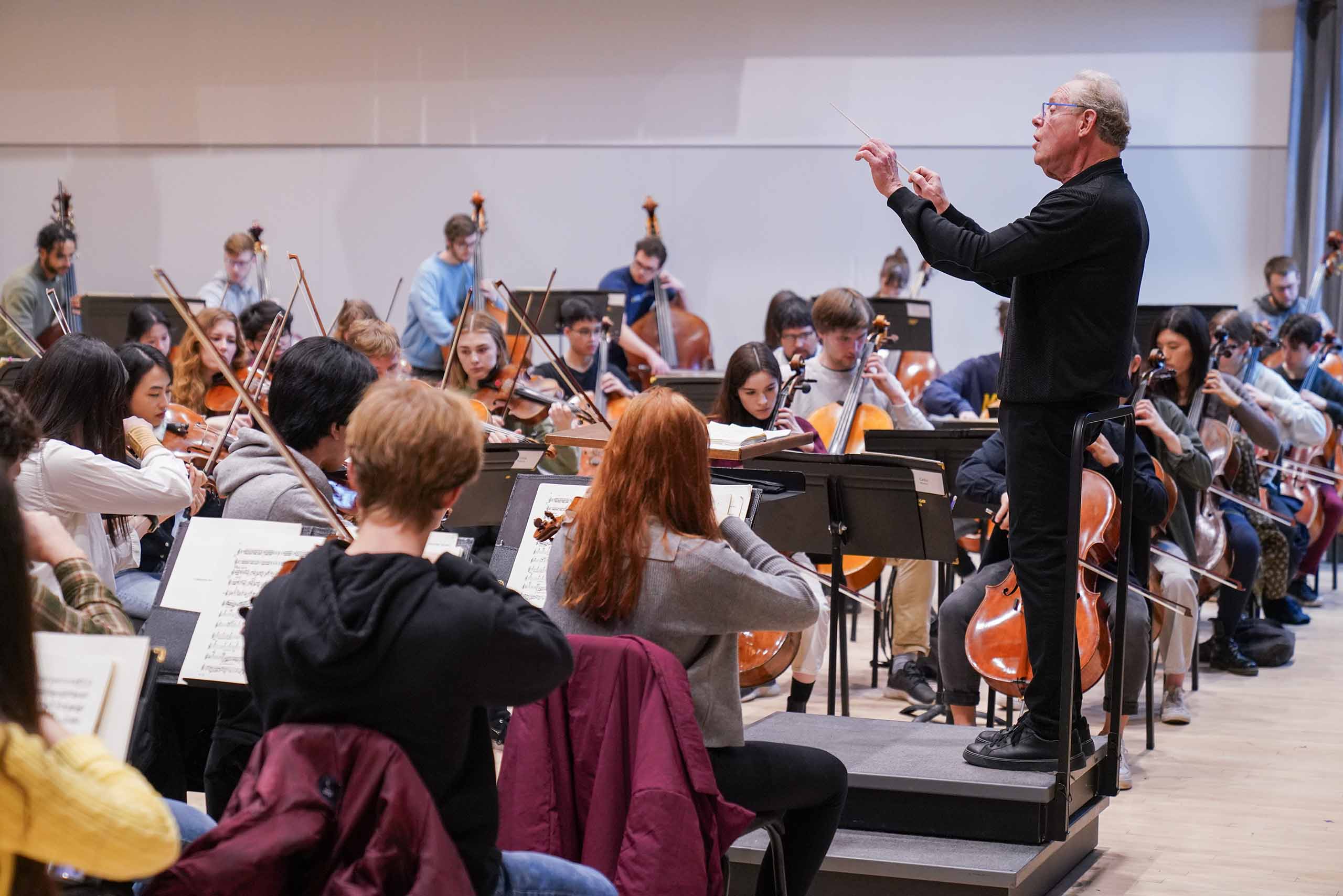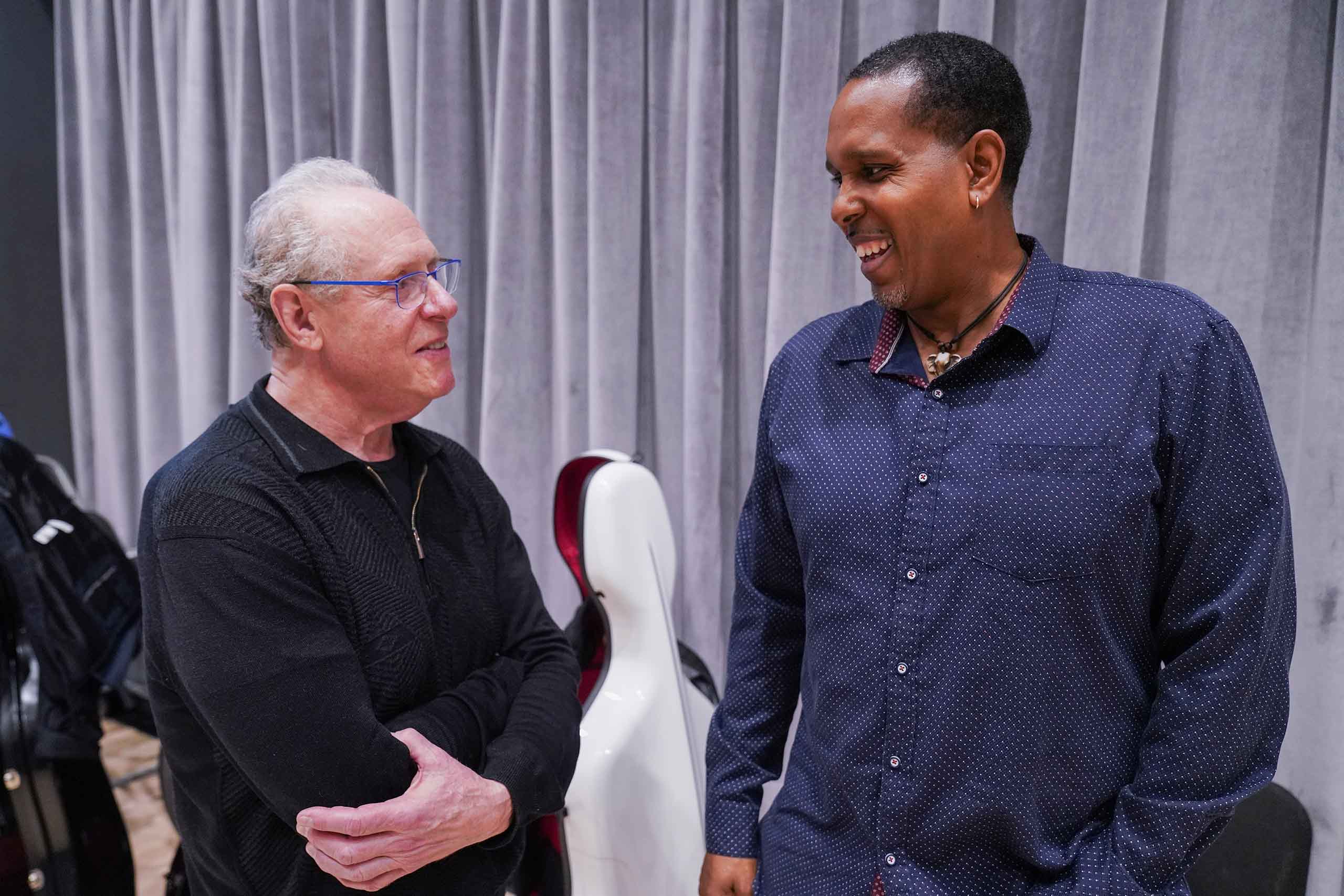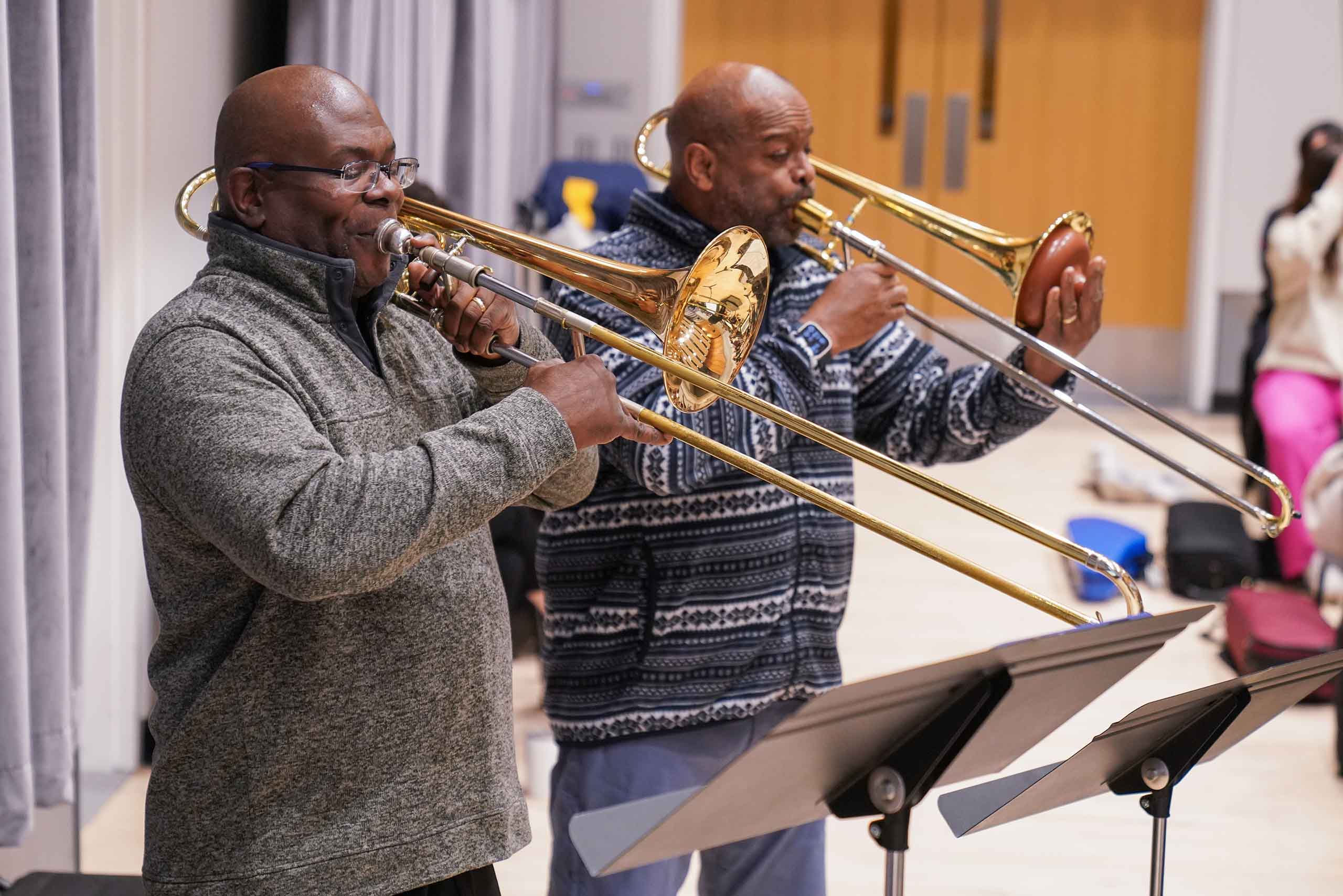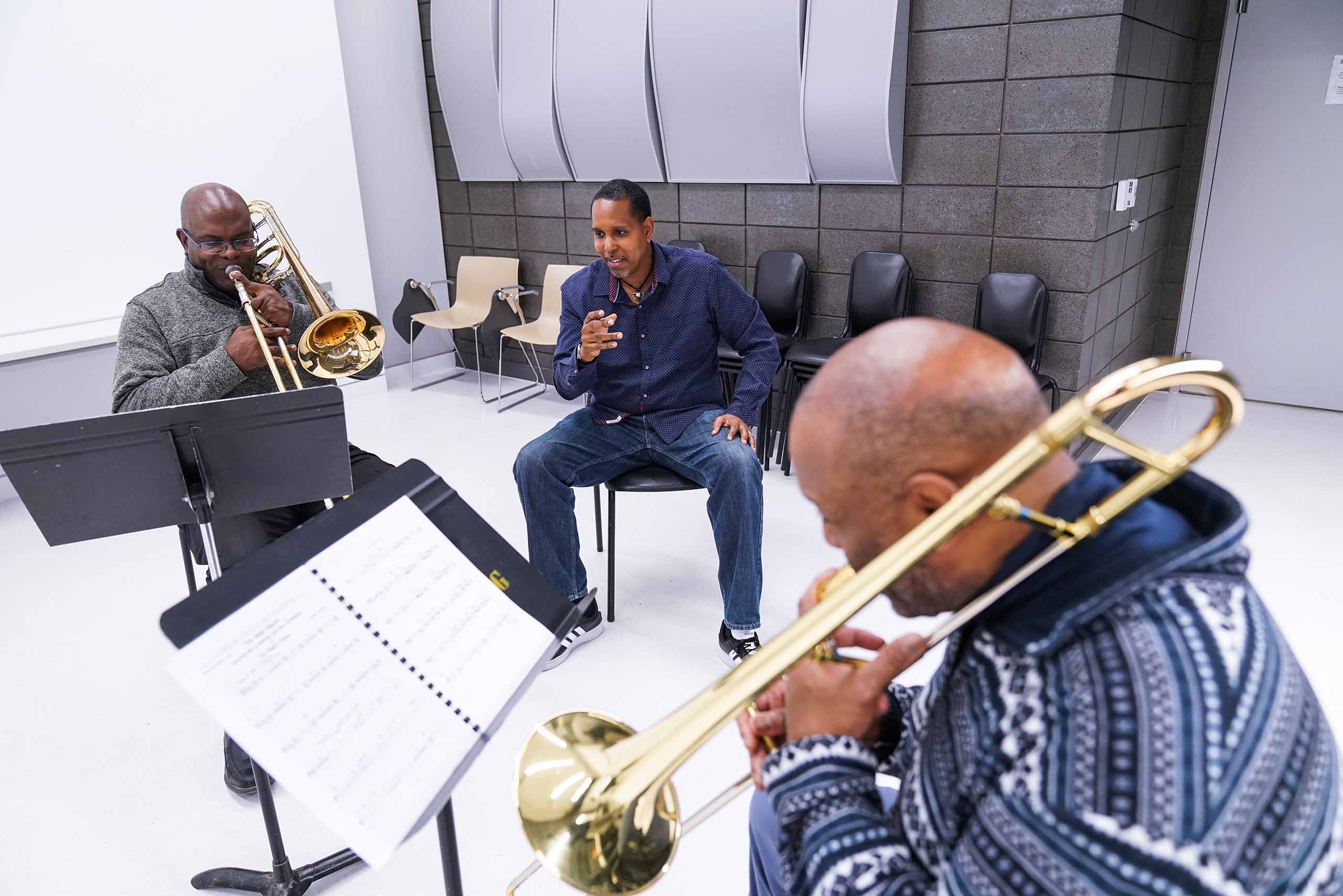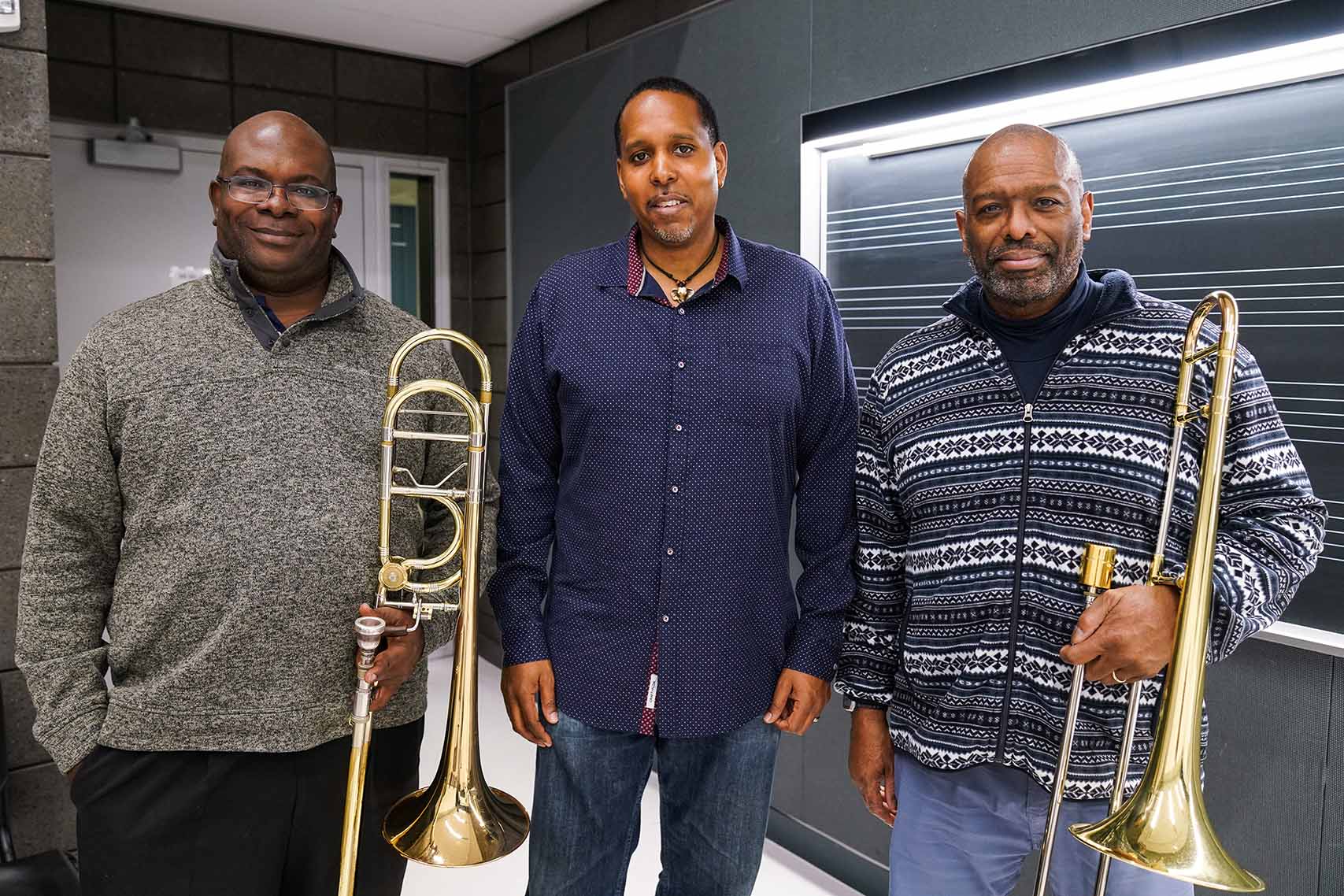Sometimes, the stars align, and the pieces of a complex puzzle just magically fall into place. That’s how it was last fall for Kenneth Kiesler, GRAMMY-nominated professor of conducting and director of university orchestras, as he sought a composer whose work he would commission as part of the MORE project. Established by Kiesler in 2020, MORE, which stands for Michigan Orchestra Repertoire for Equity, is a ten-year project to commission ten new orchestral works with the intention of diversifying and expanding the classical orchestral repertoire.
“I had the idea that the next MORE commission would be a concerto in two styles, classical and jazz,” Kiesler said. “In a second, I thought of two great artists who are faculty members, David Jackson and Dennis Wilson. I started looking for a composer who would be comfortable in both styles, and had a few on my list, but I wasn’t feeling 100 percent about any of them yet.”
Kenneth Kiesler conducts a rehearsal with the University Symphony Orchestra.
David Jackson, professor of music, is a trombonist with Detroit Chamber Winds, an in-demand clinician, and a frequent guest performer with orchestras. Dennis Wilson, associate professor of music, is the director of SMTD’s Jazz Lab Ensemble and lead trombonist for the Carnegie Hall Jazz Orchestra.
The question of the right composer for this work was top of mind for Kiesler in October, when he began working with Wynton Marsalis and the Jazz at Lincoln Center (JALC) Orchestra in preparation for the UMS presentation of All Rise, Marsalis’s epic jazz symphony. This concert was conducted by Kiesler and featured, in addition to Marsalis and the JALC Orchestra, the University Symphony Orchestra (USO) and the University of Michigan Choirs.
Kiesler asked Marsalis if he had any composers to suggest. “Wynton suggested Vince Gardner,” the lead trombonist for the JALC Orchestra, Kiesler recalled. “It was an electrifying moment – a fantastic trombonist/composer, writing a piece for two trombonists! No more than five minutes later, Vince and I had a conversation about the idea and we were off and running.”
Vincent Gardner speaks to members of the USO at a rehearsal in Hankinson Hall.
Tomorrow, April 4, 2023 – less than six months after that initial conversation – the University Symphony Orchestra will present the world premiere of the resulting work by Vincent Gardner, The Slide Shows, at Hill Auditorium. The performance will feature Jackson and Wilson as soloists.
The University Symphony Orchestra performs Tuesday, April 4, 2023, at 8:00 p.m., at Hill Auditorium. The concert is free; no tickets are required. A pre-concert lecture will take place in the lower lobby of Hill Auditorium at 7:15 p.m. Learn more.
Showcasing the Extraordinary Expressiveness of the Trombone
A musician, arranger, and composer, Gardner has been a member of the JALC Orchestra for 23 years, much of his professional career. For every one of those 23 years, Gardner has written several arrangements or composed new works for JALC and other ensembles. Most of those works have been written for jazz ensembles, with some shorter orchestral works. Clocking in around 14 minutes, The Slide Shows is Gardner’s longest work written for a symphony orchestra.
In the process of composing this work, Gardner did what any diligent student of music would do: homework. “This being the most expansive orchestral piece that I’ve written, I was studying while I was doing it, studying all the great masters,” Gardner said. “I’ve become a huge Shostakovich fan. From writing this piece, I just learned so much listening to how Shostakovich organized the orchestra.”
Kenneth Kiesler and Vincent Gardner talk after the USO rehearsed Gardner’s The Slide Shows in Hankinson Hall.
With a nod to the motion of the trombone in the title of the work, Gardner signaled his intention right from the start: to showcase the expressiveness of the instrument and to use it to tell a story. “This is kind of the hallmark of the jazz style – being able to communicate with your instrument and tell a story with your instrument,” he said. “And I think that the trombone does that more naturally than anything, because the trombone is the instrument that mimics the human voice the closest, especially if we use effects like the plunger to make a wah-wah talking kind of sound.”
Gardner felt particularly excited to be writing the piece with Jackson and Wilson in mind as the soloists: “I’ve known Dennis Wilson for a long time, and David – I’ve heard so much about him, and I’m a big fan of his playing, too.” This piece, he noted, “gave me the largest palette that I’ve ever had, and having those two great performers to play it, I mean, it was just limitless. I could write whatever I wanted to.”
On April 4, Jackson, Wilson, and the USO will bring The Slide Shows to life (along with other works on the program). The first movement, “The Slippery Dance,” was inspired by two different dances performed in African American vaudeville shows in the early 1900s: one was a snake dance involving contortionists; the other was called the sand dance, because the performers would throw sand on the floor and dance atop it, their sliding feet making a percussive sound. Gardner correlates the motions of these dances to the slide of the trombone in a movement that combines the sounds of the traditional European march and ragtime music. The movement closes with both trombones engaging in what Gardner describes as “a double-time passage that almost sounds like something percussive, like snare drums playing at each other.”
“The Cry for Understanding,” the second movement, “addresses the need for us to understand each other, and is a cry against all of the challenges we’ve been having in society lately, like gun violence and the war in Ukraine and unfair policing,” Gardner shared. “I’ve always believed that the trombone has probably the best cry of any instrument that there is.” In this movement, the two trombones intertwine and contrast with each other, with Jackson playing a written melody while Wilson uses a plunger to produce the wah-wah effect, portraying an emotional response.
David Jackson (left) and Dennis Wilson, using a plunger, rehearse Gardner’s composition.
The third movement, “Sueños para la Diáspora” (dreams for the diaspora), is a tribute to the African diaspora’s abundant contributions to the arts and culture. Gardner incorporates rhythms from various communities, he explained, including “Afro-Latin rhythms from Puerto Rico and Cuba, jazz rhythms from America, West African 6/8 rhythms from Ghana and the Ivory Coast.”
Just the Beginning
Gardner is looking forward to working with the USO and hearing his piece performed. “I’m such a fan of the orchestra, first of all. I loved how professional they were in dealing with All Rise and learning it. It was completely locked in,” he said. And the students in the USO, in working with Gardner in rehearsals, will have the rare opportunity to hear directly from the composer about the inspiration for the work and the intention for its performance. “I want to let them know that this is a living piece,” Gardner said. “It reflects the times that they live in now.”
Gardner (center in both photos) worked with Jackson (left) and Wilson during a rehearsal.
With the help of soloists Jackson and Wilson, Gardner hopes to show audiences all that he loves about the trombone. “I hope that they can recognize the versatility of the trombone, and how it sings differently in different registers, and using different effects, and all these different kinds of characters that it has. It’s really a very expressive instrument,” he said.
As for future orchestral compositions, Gardner expressed that The Slide Shows is just the beginning. Working on the piece opened up a creative avenue he is eager to explore further. “I have so many other ideas,” he shared. “I already have sketches for two or three other pieces that I’m going to write. I have the bug now, so I’ll write a lot more for orchestra. This was a lot of fun.”

